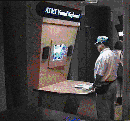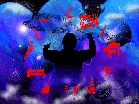|
EPCOT Projects |
||
| Home
Projects About Me
|
This page is brought to you by its author, and is not sanctioned by AT&T or Disney. It's content and accuracy are based on the author's personal experience, and personal photography. The contents herein are a fair use, and to the general benefit of the parties involved. If you're a lawyer for AT&T or Disney, don't you have something better to do? At EPCOT Spaceship Earth's Global Neighborhood: Communication BreakthroughThis game illustrates videoconferencing in a fun way. A player uses a paddle to launch balls that knock holes in a brick wall. The bricks have pictures that come in pairs, and you must hit both matching bricks to make them blow up. After a training period, the holes expose the view of a player at a different station, to whom you are connected. The gag is that now each of you only has one of the matching bricks, so you have to collaborate to knock down the wall. This game is widely regarded as successful, as not only do the people have fun, but quite a few go introduce themselves to the other players after they are done. Go give it a try!
The player's paddles are sensed by a BULLSEYE tracker. The game uses four degrees of freedom: moving left/right and up/down, and orientation left/right and up/down. The tracker senses depth front and back but it is not used because it was too hard for novice players with only a 2-D screen. Note that the actual game was developed by Disney; we supplied the tracker hardware and software, plus the PC API software. If you look carefully, you can see the BULLSEYE peeping over the top of the front mirror. You can see the lens, the box, some cables, and if you go to the right side of the aperture, you can see its power light shining through the Pepper's Ghost glass. (The main monitor is up on top --- you can see the mirror-reversed image if you look. There is a second monitor in back for the inter-station video images.) The game software, written by Disney, runs on a network of Pentiums. The game system (6 stations) is located in the ``Global Neighborhood,'' which is where you get unloaded after riding through the big AT&T globe (``Spaceship Earth''). Shorter lines can be obtained later in the day. Communication Breakthrough opened in February 1995. At EPCOT Innoventions AT&T Area: Virtual KeyboardThe Virtual Keyboard application is musical, allowing the guest to control music using a video keyboard that is tracked in 6 degrees of freedom. Not only can the 12 keys and 4 buttons provide input, but the keyboard's position and orientation can as well.
Music turned out to be fairly hard to use as the basis for a game, given the average music level of the players and the noisy background. To enable guests to be able to do something musical within a few minutes, and due to a limited time and money budget, the application's authors had to simplify it so that the 12 keys enable or disable different instruments within a composition, and the other available controls are not used. [I produced the interface, not the application.] The Virtual Keyboards were removed in the makeover at the AT&T trivestiture, since no one was too satisfied with the application, and it was more relevant to spin-off Lucent than the remaining AT&T. The kiosks remain, and the holes in the overhead grill that the BULLSEYE image processor looked through are still there.
|
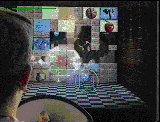
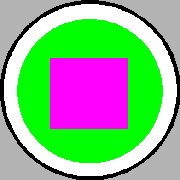 Paddle graphics
Paddle graphics
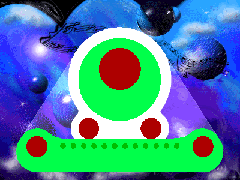 Keyboard, as seen on the original screen graphic.
Keyboard, as seen on the original screen graphic.
